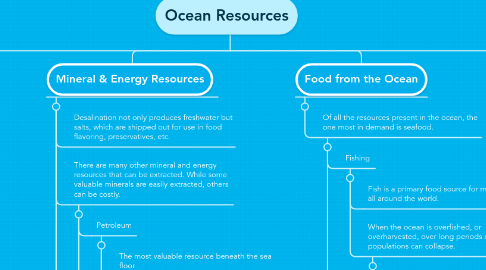
1. Fresh Water from the Ocean
1.1. With the growth of population & industry comes increased demand for freshwater, which previously had been satisfied from elsewhere in the world (such as lakes and underground reservoirs) but is now inadequately met.
1.2. People have become increasingly interested in looking to the oceans for freshwater.
1.2.1. Desalination
1.2.1.1. Extracting freshwater from saltwater (which is much more common).
1.2.1.2. The process is usually costly.
1.2.1.2.1. Distillation
1.2.1.2.2. Freezing
1.2.1.2.3. Reverse Osmosis Desalination
2. Mineral & Energy Resources
2.1. Desalination not only produces freshwater but salts, which are shipped out for use in food flavoring, preservatives, etc.
2.2. There are many other mineral and energy resources that can be extracted. While some valuable minerals are easily extracted, others can be costly.
2.2.1. Petroleum
2.2.1.1. The most valuable resource beneath the sea floor
2.2.1.2. Offshore oil and natural gas deposits exist along continental margins all around the world.
2.2.1.3. About 1/4th of the world's oil is now obtained from offshore wells.
2.2.2. Nodules
2.2.2.1. Potato-shaped lumps of minerals that are found on the abyssal plains of the ocean floor.
2.2.2.2. Valuable source of manganese, iron, copper, nickel, cobalt, and phosphates.
2.2.2.3. Recovery of nodules is expensive & difficult because their are so deep in water.
2.2.3. Trace Minerals
2.2.3.1. The ocean is also a primary source for magnesium and bromine.
2.2.3.2. Other trace elements are too small in concentration to be considered practical to extract.
2.3. Because national borders are only observed only close to land, the question of who has the right to what far out into the ocean is controversial and unanswered.
2.4. (This lesson relates very much to lesson 1 and lesson of the chapter and chapter 19.)
3. Food from the Ocean
3.1. Of all the resources present in the ocean, the one most in demand is seafood.
3.1.1. Fishing
3.1.1.1. Fish is a primary food source for many people all around the world.
3.1.1.2. When the ocean is overfished, or overharvested, over long periods of time, fish populations can collapse.
3.1.1.2.1. A collapse in the population significantly damages both
3.1.1.2.2. Accordingly, governments have set regulation to control fishing and prevent overfishing.
3.1.2. Aquaculture
3.1.2.1. Another way to deal with the high demand for seafood is farming aquatic life.
3.1.2.2. Aquaculture is the raising of aquatic plants and animals on separate farms for human use or consumption.
3.1.2.2.1. Catfish, salmon, oysters, and shrimp are already grown on large aquatic farms.
3.1.2.2.2. Similar methods may be used to breed fish and seaweed in ocean farms.
3.1.2.3. An issue with ocean farms is the risk of pollution.
3.1.2.4. Under the best conditions, aqua-farms may be able to produce more food than agricultural farms.
3.1.2.4.1. Agricultural farms only make use of topsoil. Aquaculture farms can make use of various depths of ocean water and the ocean floor.
3.1.2.4.2. One day, when the nutrient-rich abyssal plain water and soil can be pumped to the surface for fertilization, aquaculture farms will rule the farming industry.
4. Ocean-Water Pollution
4.1. The oceans have been used as a dumping ground for many kinds of wastes, including garbage, sewage, and nuclear waste.
4.2. Until recently, most of these wastes were diluted to nothingness or destroyed as they spread throughout the ocean. But the growth of the world population and the increased use of more-toxic substances have reduced the ocean's ability to absorb wastes and renew itself.
4.2.1. Productive coastal areas and beaches are at the greatest risk for pollution.
4.2.2. Traces of mercury, DDT (insecticide), and lead from gasoline have been detected far out into the ocean.
4.2.3. In some areas of the world, concentration of pollutants have made the fish in the area unsuitable for human consumption.
4.3. Pollution has destroyed clam and oyster beds, sea birds have become tangled in plastic products, and beaches have been closed because of sewage and oil spills.
4.4. Acknowledging the problem of polluting ocean water, governments and scientists have been working to reduce pollution.
4.4.1. In the US, DDTs are banned and use of leaded gasoline has been reduced.
